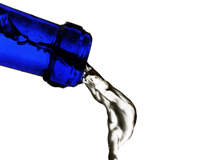
In 2002, the EU put in place the first common rules for aviation security that increased security and restrictions relating to airport and aircraft security, passenger screening and baggage handling. But new measures, announced in 2010, set a clear deadline for the lifting of the current restrictions on the carriage of liquids in cabin baggage.
From 29 April 2011 liquids in “security tamper-evident bags purchased at third country airports” will be screened, replacing the outright ban; at present, these liquids are only allowed in cabin baggage if they come from selected third countries, such as the US, Canada, Singapore and Croatia. As of 29 April 2013, all liquids will be screened in all European airports,allowing the restrictions to be lifted.
Simplified security controls
Siim Kallas, the European Commission vice-president in charge of transport, says that the measures are about building on the experience of recent years and streamlining procedures, so that on a daily basis security controls are easier for industry to implement.
“For passengers, the aim is also to simplify wherever possible the necessary security controls,” he adds. “In that sense, this package takes a significant step forwards in signalling the beginning of the end for the current restrictions on liquids in cabin baggage, with a clear and final deadline of April 2013.”
According to the EU, the transition period until 2013 is necessary to allow for a roll-out of liquid screening equipment in all EU airports. As stated in the June 2010 EU report Use of Security Scanners at EU airports, under the EU legal framework for aviation security 11 member states or airports are given a list of screening and controlling methods and technologies, from which they must choose the necessary elements in order to perform their aviation security tasks effectively and efficiently.
People scanning
Security scanner technology can effectively survey people and clothes for metallic and non-metallic items, including plastic and liquid explosives. These scanners will likely replace walk-through metal detectors, which can identify most knives or firearms, but are weak when identifying non-metallic items – as a result, full-body searches are required in order to achieve comparable results. Although prices currently stand at between €100,000 and €200,000 per scanner, costs are expected to decrease with increased production.
How well do you really know your competitors?
Access the most comprehensive Company Profiles on the market, powered by GlobalData. Save hours of research. Gain competitive edge.

Thank you!
Your download email will arrive shortly
Not ready to buy yet? Download a free sample
We are confident about the unique quality of our Company Profiles. However, we want you to make the most beneficial decision for your business, so we offer a free sample that you can download by submitting the below form
By GlobalDataLiquid detection scanners
In order to ensure that liquids carried in bags are not a security risk, new scanning equipment is being developed by manufacturers.
The UK’s Department of Transport has confirmed that many trials are taking place, and it is working with manufacturers such as Rapiscan to ensure that scanners will be able to detect different types of liquid.
Rapiscan produces one of the most advanced systems in the country. As explained by Ken Mann, aviation technical director at Rapiscan, there are four technology types that can be used to assess whether liquids are likely to be dangerous or not. Type A – the biggest challenge from an operations point of view – is to open and test each liquid. Type B is a scanner to check single bottles, Type C a system that screen several items after they have been removed from a passenger’s bag, and the Type D – which is in development and yet to be evaluated – a system that can detect liquids inside a bag.
For Rapiscan the focus is on Type C technology – its 620DV machines are widely deployed across UK airports, and are capable of scanning liquids. The system features a dual-view X-ray imaging capability that scans briefcases, carry-on baggage, laptops, small cargo parcels and other objects. It produces two HD images that increase the operator’s ability to identify potential threat items.
What is a liquid?
According to Mann the greatest difficulties during the development of the detection systems were related to the decisions being made on what exactly constituted a liquid, a view echoed by the Department of Transport..
“Some of the challenges in screening liquids come from the fact that from a security point of view numerous items are considered liquids,” he explains. “It quickly became apparent that, from a detection point of view, liquids also include aerosols, peanut butter, toothpaste, ice and all manner of ointments and other things – therefore, our algorithms have to cope with a very wide range of materials in a very wide range of configurations.”
A framework for faster travel
The EU has stated that the implementation of these new security measures at EU airports will continue to be closely monitored through unannounced European Commission inspections. This new EU framework hopes to produce, along with heightened security, faster connection times, lower costs and greater convenience for passengers.



